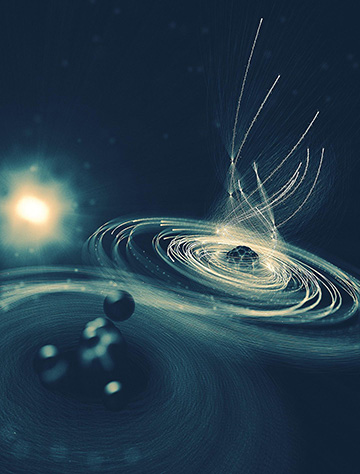
Physicists found that an extremely intense X-ray flash, hitting a molecule of iodomethane (CH3I), knocks so many electrons out of the iodine atom (right) such that it pulls in the electrons of the methyl group (left), acting as a sort of elecetromagnetic black hole. [Image: DESY/Science Communication Lab]
An international team of scientists has used the Linac Coherent Light Source (LCLS), a free-electron laser at the Stanford Linear Accelerator Center (SLAC), Calif., USA, to gain new insights on the femtosecond-scale responses of molecules exposed to hard X-rays (Nature, doi: 10.1038/nature22373). The experiments showed that upon being bombarded by X-rays, an ionized heavy atom in a molecule can suck in electrons from neighboring atoms in the molecule, turning the heavy atom into what the scientists describe as a sort of electromagnetic black hole. The surprising results, according to the team, could illuminate the femtosecond-by-femtosecond dynamics of interactions between X-rays and molecules, a crucial variable in structural biology, X-ray diffraction and other applications.
Induced charge
Hard, or high-peak-intensity, X-ray pulses have become a key tool in investigating the structure of matter and complex biomolecules, for applications such as drug development. But to use that tool, it’s essential to understand how the X-rays themselves, in real time, can damage and alter the molecular structure being investigated.
A key component of that radiation damage is the induced charge from the X-ray-driven ionization of the atoms in the molecule. It’s been assumed, based largely on studies using relatively soft X-rays, that the behavior of induced charge and subsequent redistribution of electrons in individual atoms provides a good guide to the induced-charge behavior of those atoms when arrayed in molecules—that is, that there’s no electron redistribution between atoms of a given molecule. The fact that all of this charge-shuffling takes place at sub-femtosecond timescales, however, has made it difficult to see what’s really going on in a given experiment.
Model molecules
To get a better view at the ionization processes at these high energies, the research team, led by scientists at the Deutsches Elektronen-Synchrotron (DESY), Germany, and Kansas State University, USA, focused on two relatively simple model molecules, iodomethane (CH3I) and iodobenzene (C6H5I), each of which includes organic species and a single heavy atom (iodine). Such molecules, combining a heavy atom with lighter organics, constitute important building blocks of larger, complex biomolecules.
Using the LCLS’s Coherent X-ray Imaging (CXI) instrument, the researchers focused a stream of pulses with photon energies of 8.3 keV onto a 100-nm2 patch containing such molecules, achieving intensities on the order of 1019 W/cm2. The energy level was tweaked to be high enough to ionize the innermost electrons of the iodine atoms in the molecules, making the X-ray energy effectively invisible to the carbon and hydrogen atoms.
The team then carefully measured the yields and kinetic energies of the ion fragments created as the molecule broke apart. It found that the measurements best fit a model in which the X-ray pulses first stripped 47 electrons from the iodine atom, ejecting them from the molecule and giving it an induced charge of 47+.
Then, in a surprise, in the experiment involving the iodomethane molecule, the highly ionized iodine appears to have sucked in four electrons from the molecule’s carbon atom and another three electrons from the neighboring hydrogen atoms. The process happened so quickly that these additional electrons were themselves ejected from the molecule by the same X-ray pulse, leaving behind a molecule with an induced charge of 54+. At that point, the excess positive charge caused the molecule to explode.
Modeling tool
The research team writes that the results “clearly establish that the interaction of ultra-intense, hard X-rays with molecules is fundamentally different from the interaction with isolated atoms.” As a result, understanding and interpreting hard-X-ray studies of molecules containing heavy atoms requires accounting for the kind of intra-molecular electron piracy that the team observed in the experiments.
Perhaps as notably, the study provided some new tools for doing just that kind of accounting. The researchers stressed that they were able to quantitatively describe the reaction—involving more than 50 electrons in the course of a few tens of femtoseconds—using an “intuitive, sequential model that involves a series of single-photon absorption steps,” and that’s embodied in a new computer program that constitutes another product of the study. “This is not only the first time that this experiment has been successfully carried out,” said Sank-Kil Son of DESY, one of the corresponding authors on the study. “We even have a numerical description of the process.”
In addition to scientists at Kansas State, DESY and SLAC, the team included researchers from other institutions in Japan, Germany, China, Denmark, the United States, and France.
